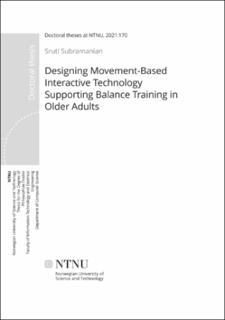| dc.contributor.advisor | Svanæs, Dag | |
| dc.contributor.advisor | Dahl, Yngve | |
| dc.contributor.advisor | Vereijken, Beatrix | |
| dc.contributor.author | Subramanian, Sruti | |
| dc.date.accessioned | 2021-05-21T10:55:43Z | |
| dc.date.available | 2021-05-21T10:55:43Z | |
| dc.date.issued | 2021 | |
| dc.identifier.isbn | 978-82-326-5291-4 | |
| dc.identifier.issn | 2703-8084 | |
| dc.identifier.uri | https://hdl.handle.net/11250/2756026 | |
| dc.description.abstract | With an increasing global population of older adults, falls are a critical problem resulting in numerous injuries, loss of independence, and fatalities. In this regard, balance training and rehabilitation play a major role in maintaining, improving, or restoring functional balance.
While traditional balance training exercises have shown to be effective in improving balance, current advancements in information and communication technology (ICT) have resulted in numerous interactive movement-based applications, some of which have shown potential in training balance. This has resulted in increasing applications of movement-based interactive technology within the healthcare sector for purposes such as balance training and rehabilitation. However, despite the identified potential and increasing attention given to movement-based interactive technology, there is limited knowledge of designing for balance training and rehabilitation.
The overall aim of the thesis is to inform the design of movement-based interactive technology supporting balance training in older adults.
The research conducted as part of the thesis has resulted in five journal and conference papers (see Part II) that address various aspects of designing for balance training among older adults: design recommendations, movement characteristics, motivational factors, and tangible interactive technology.
While the individual research papers provide specific insight into the various aspects of designing movement-based interactive technology for balance training in older adults, the thesis as a whole provides the following key findings:
• Effective balance training design solutions do not require strict puppeteering.
• Perceived health effects and joy are the main motivational factors for older adults.
• Simple, tangible interactive solutions show promise for balance training.
• As a tool for physiotherapists, a key success factor for balance training solutions is that they are easily tailorable.
In conclusion, the thesis suggests looking beyond conventional screen-based solutions. Simple, tangible interactive technology shows potential in physiotherapy for overcoming various drawbacks associated with screen-based solutions. | en_US |
| dc.language.iso | eng | en_US |
| dc.publisher | NTNU | en_US |
| dc.relation.ispartofseries | Doctoral theses at NTNU;2021:170 | |
| dc.relation.haspart | Paper 1: Subramanian, Sruti; Dahl, Yngve; Skjæret-Maroni, Nina; Vereijken, Beatrix; Svanæs, Dag. Twelve Ways to Reach for a Star: Player Movement Strategies in a Whole-Body Exergame. I: 2019 IEEE 7th International Conference on Serious Games and Applications for Health (SeGAH). IEEE conference proceedings 2019 © 2019 IEEE. Personal use of this material is permitted. Permission from IEEE must be obtained for all other uses, in any current or future media, including reprinting/republishing this material for advertising or promotional purposes, creating new collective works, for resale or redistribution to servers or lists, or reuse of any copyrighted component of this work in other works. | en_US |
| dc.relation.haspart | Paper 2: Subramanian, Sruti; Dahl, Yngve; Skjæret-Maroni, Nina; Vereijken, Beatrix; Svanæs, Dag. Assessing Motivational Differences Between Young and Older Adults When Playing an Exergame. Games for Health Journal 2019 ;Volum 9.(1) s. - | en_US |
| dc.relation.haspart | Paper 3: Subramanian, Sruti; Skjæret-Maroni, Nina; Dahl, Yngve. Systematic Review of Design Guidelines for Full-Body Interactive Games. Interacting with computers 2021 | en_US |
| dc.relation.haspart | Paper 4: Svanæs, Dag; Lyngby, Andreas Scharvet; Bärnhold, Magnus; Subramanian, Sruti. “UNITY-Things: An Internet-of-Things software framework integrating Arduinoenabled remote devices with the UNITY game engine,” Accepted for publication in HCI International, 2021. This article is awaiting publication and is therefore not included. | en_US |
| dc.relation.haspart | Paper 5: Subramanian, Sruti; Dahl, Yngve; Vereijken, Beatrix; Svanæs, Dag. ExerTiles: A Tangible Interactive Physiotherapy Toolkit for Balance Training with Older Adults. I: OZCHI'20: Proceedings of the 32nd Australian Conference on Human-Computer-Interaction. ACM Publications 2020 ISBN 978-1-4503-8975-4. s. 233-244 This article is not included due to copyright restrictions. Available at https://doi.org/10.1145/3441000.3441043 | en_US |
| dc.title | Designing movement-based interactive technology supporting balance training in older adults | en_US |
| dc.type | Doctoral thesis | en_US |
| dc.subject.nsi | VDP::Teknologi: 500 | en_US |

